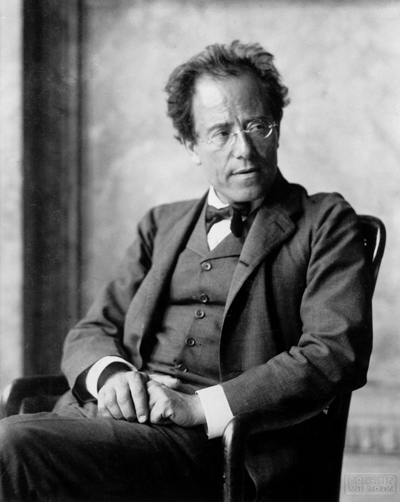
Gustav Mahler
One of the most renown conductors during his lifetime, Mahler’s commanding position today as a symphonic composer came about only a half century after his death. Mahler’s music represents the culmination of the Austro-German late-Romantic orchestral tradition.
Despite being principally a conductor of opera, Mahler wrote no operas. Instead, his works are confined to two genres: Lieder (song) and the symphony. These two genres came together in Mahler’s hands as he incorporated songs into his symphonies and expanded songs into symphonic proportions. The relationship between symphony and song forms one of the most important characteristics of his artistic output.
Mahler has a highly distinctive voice that the listener soon comes to recognize. Filled with folk tunes, dance rhythms, the lyricism of song, and highly innovative orchestrations, his music appeals to a wide audience.

Personal Data
Dates: 1860-1911
Born: Kaliště, Bohemia
Residences: Kassel, Prague, Leipzig, Budapest, Hamburg, Vienna, New York
Mahler Timeline
Early Works
Major early works
Lieder eines fahrenden Gesellen
Des Knaben Wunderhorn
Symphonies 1 – 4
To begin our exploration of Mahler’s music, we will look at his song cycle Lieder eines fahrenden Gesellen (Songs of a Wayfarer) and excerpts of his Symphony No. 1.
(The video excerpts may begin and end abruptly, but this is just a way of pointing you to specific passages. The entire works are in the videos and it will all play if you move the pointer to the beginning.)
The text of Lieder eines fahrenden Gesellen was written by Mahler himself in 1884-1885 when Mahler had experienced disappointment in an early love. Hence the rather gloomy opening song “When My Sweetheart Is Married,” and the stormy “I Have a Gleaming Knife” (in my breast). Full German and English texts can be found here.
In Mahler’s music, rage is often paired with peace and gloom with ecstasy, and his vast emotional palate does much to answer the question of why audiences find his music so compelling. In the second song of this cycle, Ging heut morgen übers Feld (I went across the field this morning), the narrator’s sorrow at seeing his love married to another is tempered by the beauty of the world.
Ging heut morgen übers Feld (excerpt)
I went across the field this morning
Dew still hung on the grass;
Said the merry finch to me:
“Hey you! Good morning! Isn’t it!
Won’t it be a beautiful world?
Chirp! Chirp! Beautiful and nimble!
How the world pleases me!”
Symphony No. 1 (excerpt from 1st movement)
The video is cued to the beginning of the main theme based on the song above. A slow introduction has given way to a bird call heard in the clarinet and flute.
Mahler’s music is filled with allusions to life around him, not so much in depicting nature, but more often with songs and dances and the use of specific instruments.
Die zwei blauen Augen von meinem Schatz (excerpt)
“The Two Blue Eyes of my Beloved”
On the street stood a linden tree,
That’s when I rested in my sleep
for the first time!
under the linden tree,
Which snowed its blossoms over me.
I didn’t know what life was like,
All was well again! All! All!
Love and sorrow, and world and dream!
Symphony No. 1 (3rd movement)
Let us now consider the full third movement of this symphony. The song above appears within the movement very much as it does in the song cycle.
The movement overall depicts a funeral march. It begins with the familiar tune of Frère Jacques in a minor key played as a round. Over this Mahler provides a dotted-rhythm slow march melody and the steady footfall of the timpani.
There follows a section of Jewish Klezmer music, perhaps Mahler’s most vivid depiction of his Jewish roots.
The peaceful song from Lieder eines fahrenden Gesellen contains notes of sorrow (just as within the song itself) with slight dissonances and shifts to the minor key.
While these elements are featured within clearly delineated sections, they also combine in various ways throughout the movement. This pastiche of moods and contradictory emotions is typical of Mahler. Profound feelings may be expressed with naivety. And what is more human than the mixture of love and sorrow?
How does Mahler accomplish this? He does it in part with a new approach to the orchestra. He needs a large orchestra for the loud and bold sounds that frequently characterize his works. But more than that, he needs a greater number of players for the incredible variety of sounds and textures that he creates.
Notice as you listen how sparingly Mahler uses his resources and how the texture is frequently so transparent. He uses solo instruments and pairs of instruments in unusual combinations. A single line may be passed in short order from the color of one instrument to another and still another. His technique is sometimes described as chamber music for orchestra.
The large forces and descriptions like “Symphony of a Thousand” (Symphony No. 8) mask the intimacy of song and solo instruments.
Friday Performance Picks: Works by Mahler
No. 103: Symphony No. 1 (2nd movement)
No 226: Symphony No. 7 (finale)
No. 320: Urlicht (from Symphony No. 2)
(You must be logged into the Circle of Scholars to view the rest of this page.)
